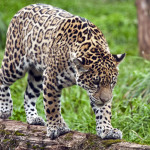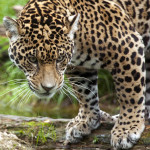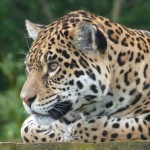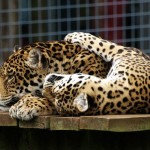Sri Lankan Leopard
Panthera pardus kotiya
Habitat: The leopard has been observed in a variety of habitats including dry evergreen monsoon forest, arid scrub jungle, low and upper highland forest, rainforest, and wet zone intermediate forests.
Reproduction: Average gestation: 96 days Average litter: 2.5 cubs
Description: The reproductive season is year-round but peaks during May. Females attract potential mates by excreting pheromones in their urine. A breeding pair can mate up to 100 times per day for several days, during which time they share food resources. Leopard cubs weigh less than 1 kg at birth, and their eyes remain closed for the first week. Mothers leave their cubs in the protection of dense bush, rock clefts, or hollow tree trunks for up to 36 hours while hunting and feeding. They move den sites frequently, which can help prevent cubs from falling prey to predators. Cubs learn to walk at 2 weeks of age and regularly leave the den at 6 to 8 weeks old, around which time they begin to eat solid food. Mothers share less than a third of their food with their cubs. Cubs are completely weaned by 3 months old and independent at around 20 months old. Often, siblings maintain contact during the early years of independence.
Conservation status: Endangered. Leopards have been highly prized for their coats throughout their range and their bones have also started to replace tiger bones in traditional medicine, thus adding to the demand for poached individuals. Although renowned as adaptable creatures, the destruction of their native habitat is a further threat.
Average life span
Ave in the wild: 11 years
Ave in captivity: 22 years
Characteristics: Sri Lankan Leopards are solitary hunters, with the exception of females with young. . They mark their territory with urine, feces and claw marks and communicate with other leopards by growling, roaring, spitting and by purring. They also make a rasping cough to advertise their presence. Both sexes live in overlapping territories. They prefer hunting at night, but are also active during dawn and dusk, and daytime hours. The Sri Lankan leopard hunts like other leopards, silently stalking its prey until it is within striking distance where it unleashes a burst of speed to quickly pursue and pounce on its victim. They can run at bursts of up to 60 km/hour, jump more than 6 m horizontally and 3 m vertically. The prey is then usually dispatched with a single bite to the throat as their broad head and large skull allow for powerful jaw muscles. The cat has been known to tackle almost fully grown buffalos. They rarely haul their kills into trees, which is likely due to the lack of competition and the relative abundance of prey. Since Sri Lankan leopards are the apex predators they don’t need to protect their prey. They are comfortable in water and are adequate swimmer.
- Their shoulder has specialised attachment sites for large climbing muscles.
- Their long whiskers in their eyebrows protect their eyes while moving through dense vegetation.
- Their broad head and large skull allows for powerful jaw muscles.
- Their spots and rosettes provide excellent camouflage.










